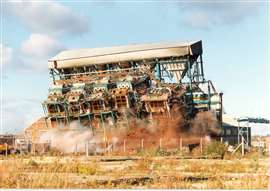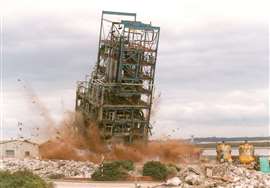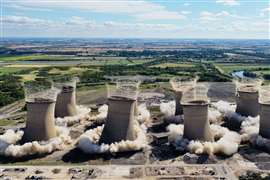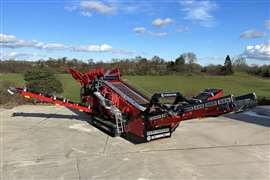Explosive Demolition: Ensuring Safety Through Relevant Good Practice
04 June 2025
In the first of a three-part series, John Wolstenholme, Principal Specialist Civil Engineering Inspector for the Office for Nuclear Regulation, shares his personal insights into the critical components of safety and Relevant Good Practice (RGP) for explosive demolition projects, including Nuclear Licensed sites.
 Demolition of the five coal-fired boilers on the former chemical manufacturing site at Widnes, United Kingdom. (PHOTO: J Wolstenholme)
Demolition of the five coal-fired boilers on the former chemical manufacturing site at Widnes, United Kingdom. (PHOTO: J Wolstenholme)
Explosive demolition offers the option of significant safety benefits by replacing conventional demolition methods with a single, controlled event. However, executing such projects requires meticulous planning, peer-reviewed design, robust safety measures, and a Suitably Qualified and Experienced (SQEP) competent team.
In his paper, John Wolstenholme outlines the key elements of Relevant Good Practice (RGP) for explosive demolition, particularly when working on high-risk sites, including nuclear facilities.
Here, D&Ri distills the highlights and takeaways from his insights, providing a practical guide for professionals in the demolition sector. (The original papers can be found on the CROSS website).
Key Principles of Safe Explosive Demolition
The Role of the Client and Project Team
Success hinges on an “intelligent client”—an organisation with the competence to oversee the project’s scope, manage risks, and ensure compliance with legal and safety standards.
“An intelligent customer is defined as an organisation that has the competence to specify the scope and standard of a required product or service and assess whether the supplied product or service meets the specified requirements.”
The client must assemble a competent project team to collect all available information about the structure, produce a safety case, and supervise the contractor effectively.
Regulatory Compliance and Standards
An explosive demolition project should meet the legal requirements of the country in which the work is to be undertaken and/or designed.
In the UK, explosive demolition is governed by the Health and Safety at Work Act 1974, the Construction Design Management Regulations (CDM) 2015, the Explosive Regulations 2014, together with recognised standards, such as BS 6187:2011 for demolition, BS 5607:2017 Code of Practice for the Safe Use of Explosives in the Construction Industry and BS 5975:2024, is required.
Adherence to these standards demonstrates that risks are being managed “so far as is reasonably practicable” (SFAIRP).
“The UK regulatory regime is a ‘goal-setting’ regime rather than a more prescriptive standards-based regulatory regime. This encourages continuous improvement and the adoption of RGP as a mechanism for demonstrating compliance with the goal-setting requirements of the law.”
Safety Management Systems (SMS)
A robust SMS is essential for managing risks. It includes clear documentation of responsibilities, milestone reviews, and thorough monitoring.
For nuclear sites, the SMS forms part of the licensee’s safety case, including Risk Assessments and Methods Statements (RAMS), which ensures continuous oversight throughout the project lifecycle.
“The SMS, together with the selection of a competent contractor and appropriate contractual arrangements, influences the engineering design and how the works are undertaken and supervised.”
Planning and Preparation
Detailed planning mitigates risks and enhances certainty in project execution. This includes creating a risk register, conducting optioneering studies, and involving the demolition contractor early in the process.
Comprehensive Pre-Construction Information (PCI) required under the UK CDM 2015 regulations should include details on services, structural and plant arrangements, and potential hazards, as well as contingency and communication plans.
“The degree and rigour of planning should reflect the complexity, novelty, hazards, unknowns, and risks from the structure to be demolished. Greater information provides better understanding and certainty, whilst information gaps lead to higher uncertainty, requiring extra caution, conservatism, and contingency planning.”
Engineering and Design
Explosive demolition designs must be conservative, fault-tolerant, and rigorously peer reviewed by third-party SQEP persons where required under BS 5975-1:2024.
Utilising tools like 3D Building Information Modelling (BIM) can improve the accuracy of design of the collapse philosophy and enhance stakeholder communication.
“The design should be demonstrably robust and supported by a transparent audit trail, ensuring it is fault-tolerant and safe to undertake.”
The Importance of Learning from Experience
Wolstenholme emphasises the need for the industry to draw lessons from past incidents, such as those at Gorbals Tower Block, Glasgow (1993), Royal Canberra Hospital (1997) and Didcot Power Station (2016) (note: still under investigation).
These events underscore the critical importance of robust systems of work and informed decision-making.
“These highlight the importance of the available learning from past incidents during explosive demolition and developing safe and robust systems of work.”
 The explosive demolition of the paraquat distillation column at Widnes, United Kingdom. (PHOTO: J Wolstenholme)
The explosive demolition of the paraquat distillation column at Widnes, United Kingdom. (PHOTO: J Wolstenholme)
4 Key Takeaways For Safely Undertaking Explosive Demolition
1. Competent Leadership: The client’s capability to act as an intelligent customer is fundamental.
“An intelligent customer understands the hazards involved, specifies suitable standards, supervises the work, and evaluates whether relevant standards and legal requirements have been met.”
2. Detailed Risk Assessment: Every hazard must be identified and mitigated through conservative engineering and design.
“A detailed plan provides focus to assure the production of a safe design and site works whilst providing commercial certainty with a reduced risk of increased costs and time.”
3. Comprehensive Planning: Clear documentation and early involvement of experienced contractors streamline the process.
“Planning requires identifying the conditions, hazards, methods and opportunities that provide certainty and reduce risks, SFAIRP [ so far as is reasonably practicable]. Competent planning includes consideration of options and their feasibility, which generally reduces design risks.”
4. Safety Culture: A commitment to learning from past projects and adopting RGP ensures ongoing improvements in safety and efficiency.
“This approach helps them to learn from previous shortfalls and past incidents together with examples of good practice on safety culture.”
Explosive demolition, while inherently high-risk, can be executed safely with the right planning, resources, control measures and SQEP expertise.
By adhering to the principles of RGP, stakeholders can minimise risks and achieve successful outcomes.
Click here to read the full technical paper by John Wolstenholme.

About the Author John Wolstenholme is a Chartered Engineer and Principal Nuclear Safety Civil Structural Specialist Inspector at the UK Office for Nuclear Regulation (ONR), where he has regulated construction, decommissioning and demolition activities on nuclear licensed sites since 2005. His 40-plus-year career spans site engineering, structural design, and explosive demolition across civil, industrial, petrochemical, and nuclear sectors. John has played a lead regulatory role in major projects at sites including Sellafield, Dungeness A, Sizewell A, Trawsfynnyd and Hinkley Point C, and has overseen some of the UK’s most complex explosive demolitions—such as the Calder Hall and Chapelcross cooling towers, Hunterston’s wind turbine mast, and the recent Sizewell A Turbine Hall. A Fellow of both the Institution of Structural Engineers and the Institute of Explosive Engineers (IExpE), John served as IExpE President from 2014 to 2015. He is Vice Chair of the EFEE Shotfiring Technical Committee, a technical author for British Standards on demolition and explosives, and has contributed specialist advice on a number of fatality investigations, including the Didcot Power Station collapse. |
CONNECT WITH THE TEAM









